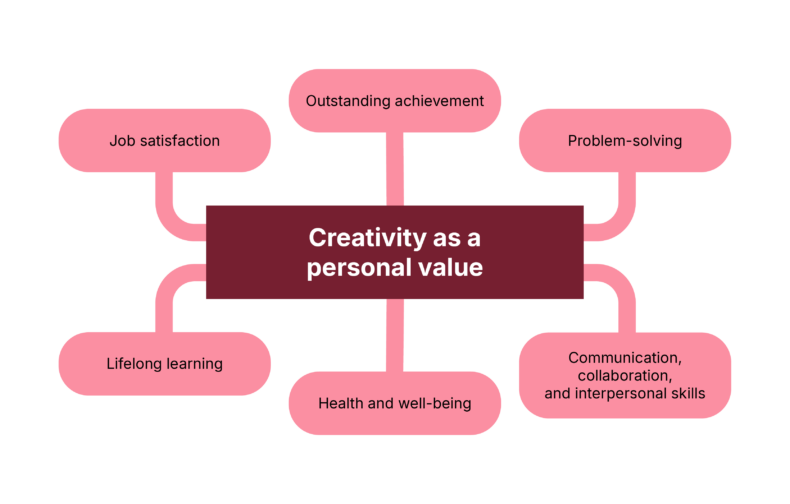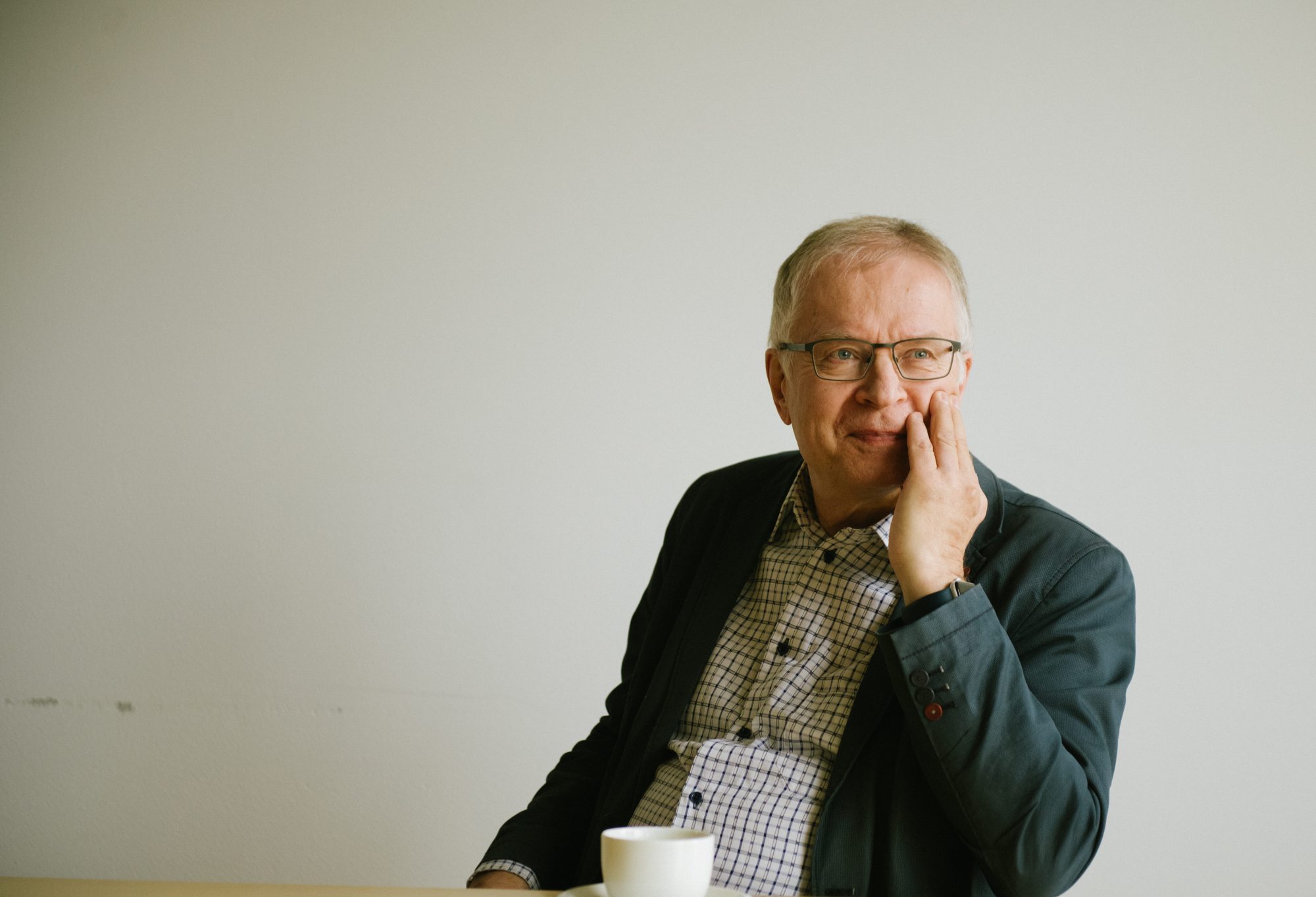What is creative thinking and how can you leverage it? What happens in your brain when you engage in creative thinking?
Investigations of what happens in the brain when people perform creative thinking tasks found interactions between three brain networks7,2,9. Brain networks are basically networks of neurons that are anatomically connected or functionally interdependent, making different areas of the brain work together during activities or changes in behaviour4.
The default mode network (DMN) contributes to creative thought by enabling a mental state in which the mind can wander freely, make connections between distant ideas, reflect on past experiences, imagine future possibilities, and examine thoughts, all while maintaining a balance with other cognitive processes.
The executive attention network (EAN) is another critical component in creative thought, complementing the DMN. While the DMN is associated with mind-wandering and spontaneous thinking, the EAN is involved in controlled, goal-directed thought51. More specifically, the EAN contributes to creative thought by maintaining focused attention, enhancing working memory and cognitive flexibility, controlling inhibition, aiding in decision-making and evaluation, setting goals and planning.
The salience network is the third brain network involved in performing creative action. It’s crucial for identifying salient (relevant, noticeable, or prominent) stimuli, integrating external and internal information, regulating emotions, detecting and resolving conflicts, enhancing cognitive flexibility, balancing exploration and exploitation of ideas, and allocating attention effectively. The salience network also facilitates switching between the DMN and EAN.
The main takeaway is that different patterns of neural activation and deactivation are important at different stages of the creative process. Overall, the cooperation between these three brain networks results in coherent, meaningful plans and actionable ideas, which can be evaluated as incremental or radical creativity.
Creative thinking is a function of the human brain that gets triggered when we engage in a novel, unusual and creative activity. It involves the ability to pay attention to the details of the situation and combine what we see, hear and feel with what we know in order to come up with a solution that is original, surprising and useful.
Quiz
Well done! You have successfully completed this assignment.
Give us feedback!
We’d love to hear your feedback on the course! You can share your thoughts anytime during your journey. The feedback link is at the top left-hand side of the page. We hope you can take a moment to let us know what you think!
Great that you’re here!
Give feedbackThree creative thinking skills
Creative thinking is an umbrella term which refers to different thinking processes, such as imagination, inspiration, and intuition.
Imagination is the ability to think of something that doesn’t yet exist1. In this chapter, we’re mainly interested in two imaginative activities: mind-wandering and daydreaming.
Mind-wandering refers to a state in which the mind drifts away from the task at hand and starts to engage in spontaneous, unrelated thoughts. It’s characterized by a lack of attention to the external environment or to a specific task, and it can happen unintentionally or spontaneously. Daydreaming is a type of mind-wandering, but it’s often considered to be more structured and fanciful. Daydreaming involves deliberate thoughts, fantasies or imaginations about events that aren’t happening15.
When engaged in a creative task, it helps to know at what stage either of these two imaginative activities can be beneficial.
Another important element is inspiration, which psychology researchers consider a state of mind that enables people to envision possibilities that they haven’t seen before. In the creative process, the inspired mind provides the motivation and curiosity to bring an envisioned possibility to fruition10,11,12,13,14.
Getting into an inspired state of mind can require being involved with a creative task and exploring it for some time. There’s also an element of luck or serendipity in getting into an inspired state of mind.
Intuition can be defined as a sense of knowledge without explicit supporting evidence or arguments. It’s an unconscious process that’s vital in creativity8. Intuition can sometimes make people realize that there’s something to be discovered, that there’s something not quite right and they need to change direction or that the solution is about to reveal itself. For French philosopher Henri Bergson, intuition is at the heart of the creative act3.
The synergies between these types of thinking can result in incremental or radically creative ideas.
Reflection
Do you believe in imagination?
Well done! You have successfully completed this assignment.
Six benefits of using your creative thinking
If you made an effort to improve your creative thinking, what benefits might you enjoy?
Forgeard & Kaufman6 identify the personal value of creativity as one of the main reasons why it’s worth cultivating. Creativity is an inherently valuable human characteristic, like wisdom, kindness, generosity, respect, honesty, courage and humility. When you use your creativity in combination with other qualities, it can make you stronger and healthier, as well as leading to stronger and healthier relationships and communities.
Moreover, when creativity is one of your core personal values, it becomes about more than just producing creative work. It becomes about embodying a creative approach to life. It influences how you interact with your environment, engage with others and perceive your own experiences and possibilities.

As you can see from Figure 2.1.1. above, creativity as a personal value can be reflected in multiple ways.
Job satisfaction
A creative person seeks to achieve better performance in the workplace, experience lower stress levels and enjoy greater personal growth.
Outstanding achievement
Highly creative thinking can lead to exceptional accomplishments in your field.
Problem-solving
Creative thinking can help you get better at solving unexpected problems. In the workplace, creativity is crucial for overcoming professional obstacles, such as developing a new product, improving a process, or finding new ways to engage customers.
Communication, collaboration, and interpersonal skills
Creative thinking can improve communication and interpersonal relations. For example, finding unique ways to express appreciation or resolve misunderstandings can strengthen bonds. Creative approaches, such as planning unconventional activities or thoughtful gestures, can revitalize relationships and help navigate difficult times.
At work, employees might benefit from using creativity when interacting with clients. It can help with identifying customers’ needs, crafting services to fit them and addressing customer complaints.
Lifelong learning
Creative individuals often value continuous learning and exploration, as these activities fuel their creative potential and feed diverse interests.
Well-being
Creativity can lead to a sense of meaning, self-actualization and authenticity. When creativity is understood as engagement in artistic activities, such as crafts, drawing, singing or dancing, it can generate positive emotions like awe, joy, gratitude, hope, inspiration and vitality.
Case study
Forest in the city
Little Finland is a building in the center of Helsinki, created by the architect Jaakko Torvinen. His creative idea was to bring forest into city. Watch a video.
Well done! You have successfully completed this assignment.
We conclude by taking a creativity assessment as well as listing some strategies to experiment with for boosting creative thinking.
Creativity assessment
Yellow is a Finnish company specializing in measuring creativity. The company also collaborates with Aalto. Take their creativity assessment, and pay attention to the questions from a learning perspective, as they reflect many lessons from this course.
Take the assessment here.
Strategies for developing creative thinking
- Look at a situation and imagine an improvement or disruption. For instance, the real-life activity below involves folding paper into different shapes. A classic example would be an airplane. Imagining an improvement or a disruption would result in questions such as ‘What would I change in the initial design so it could fly for longer?’ or ‘What if instead of a paper plane, I tried making a paper helicopter?’
- Change your perspective on a situation. For instance, try placing yourself in someone else’s shoes. ‘What if I asked an interior designer, what would they craft out of printer paper?’
- Challenge what’s taken for granted. For example, printer paper is usually around 0.05 to 0.10 millimetres thick. Questioning this standard would result in asking questions such as ‘What if I found a way to make the paper twice as thick? What would I be able to craft then?’
In addition, here are three awareness tasks that improve creative thinking:
- Try to recognize creativity in other people’s actions.
- Try to recognize the activities that require creativity.
- Try to recognize your strengths and weaknesses in creative thinking.
Real-life Activity
Hands on!
Well done! You have successfully completed this assignment.
Keywords
Imagination, inspiration, intuition, brain network, creative activity, creative thinking, default-mode network, executive attention network, salience network.
References
- Abraham, A. (2018). 11 The Forest versus the Trees: Creativity, Cognition and lmagination. In Rex, E. Jung, Vartanian, Oshin (Eds). The Cambridge handbook of the neuroscience of creativity (p. 195-210).
- Beaty, R. E., Benedek, M., Kaufman, S. B., & Silvia, P. J. (2015). Default and executive network coupling supports creative idea production. Scientific reports, 5(1), 10964.
- Bergson, H. (2022). Creative Evolution. London: Routledge.
- Bressler, S.L. & Menon, V. (2010). Large-scale brain networks in cognition: emerging methods and principles. Trends in Cognitive Sciences, Volume 14, Issue 6, Pages 277-290, ISSN 1364-6613.
- Christoff, K., Gordon, A. M., Smallwood, J., Smith, R., & Schooler, J. W. (2009). Experience sampling during fMRI reveals default network and executive system contributions to mind wandering. Proceedings of the National Academy of Sciences, 106(21), 8719-872.
- Forgeard, M. J., & Kaufman, J. C. (2016). Who cares about imagination, creativity, and innovation, and why? A review. Psychology of Aesthetics, Creativity, and the Arts, 10(3), 250.
- Gotlieb, R. J., Hyde, E., Immordino-Yang, M. H., & Kaufman, S. B. (2019). 34 – Imagination is the seed of creativity. In James C. Kaufman (Eds). The Cambridge handbook of creativity, 2, 709-731.
- Hardman, T. J. (2021). Understanding creative intuition. Journal of Creativity, 31, 100006.
- Kaufman, S.B. (2013). The Real Neuroscience of Creativity. Blog article published online at Scientific American.
- Kounios, J. et al. (2006). The prepared mind: Neural activity prior to problem presentation predicts subsequent solution by sudden insight. Psychological science, 17(10), 882-890.
- Kounios, J. et al. (2008). The origins of insight in resting-state brain activity. Neuropsychologia, 46(1), 281-291.
- Oleynick, V. C., Thrash, T. M., LeFew, M. C., Moldovan, E. G., & Kieffaber, P. D. (2014). The scientific study of inspiration in the creative process: challenges and opportunities. Frontiers in Human Neuroscience, 8, 436.
- Thrash, T. M., & Elliot, A. J. (2003). Inspiration as a psychological construct. Journal of Personality and Social Psychology, 84, 871–889.
- Thrash, T. M., Moldovan, E. G., Oleynick, V. C., & Maruskin, L. A. (2014). The psychology of inspiration. Social and Personality Psychology Compass, 8(9), 495-510.
- Zedelius, C. M., & Schooler, J. W. (2016). The richness of inner experience: Relating styles of daydreaming to creative processes. Frontiers in psychology, 6, 2063.
2. Individual
In this chapter, we explore the individual facets of radical creativity that relate to our selves and our creative identity.
2.1 Creative thinking
You’ll explore creative thinking and its neuropsychological basis, along with three key thinking skills. You will also take a personal creativity assessment.
2.2 Inner motivation to create
You’ll delve into two routes to radically creative action: self-determination at work and realizing psychological needs, both of which lead to intrinsic motivation.
2.3 Curiosity and critical thinking
You’ll learn how identifying challenges can drive radically creative outcomes through curiosity, imagination and critical thinking.
2.4 Cultivating a creative identity
You’ll gain insights into four types of creative identities: artistic, abstract ideas, entrepreneurial and empowering.
2.5 Creativity and well-being
You’ll explore three avenues for expressing creativity: tackling challenges in work contexts, experimenting with creative identity, and self-actualization.
